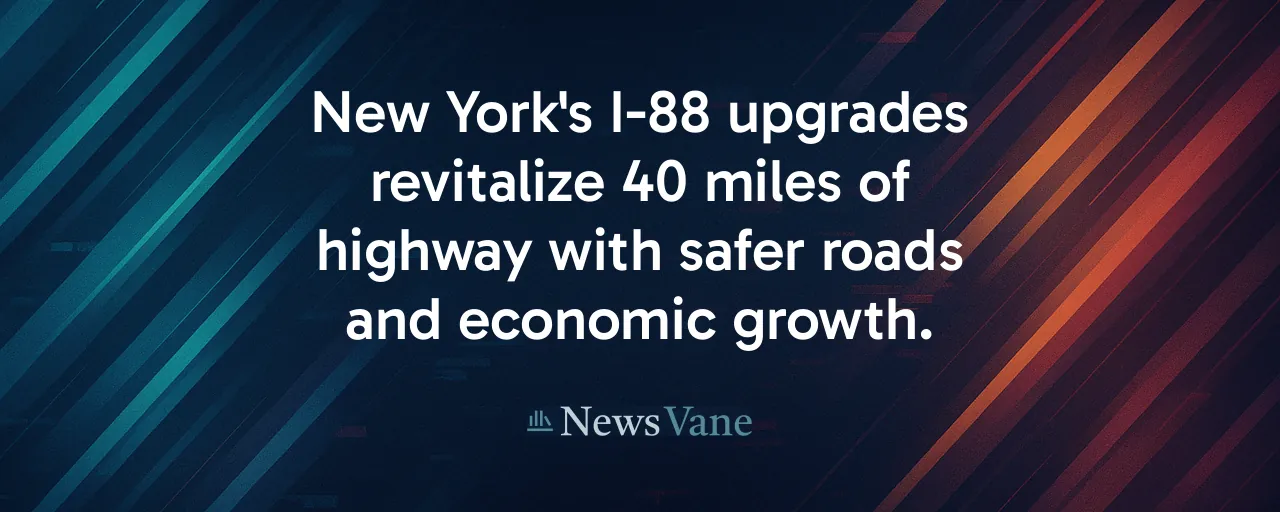Reviving a Vital Route
Interstate 88 weaves through New York's heartland, connecting the Capital Region to the Southern Tier. Now, two projects totaling nearly $42 million are transforming 40 lane miles in Schoharie and Otsego counties. By resurfacing worn pavement and upgrading safety features, the work aims to make travel smoother and more reliable for thousands of daily drivers. For rural communities, these changes promise stronger economic ties and a boost for tourism hubs like Cooperstown's National Baseball Hall of Fame.
This effort, launched in 2024, taps into a national push to renew aging infrastructure. With funds from the 2021 Bipartisan Infrastructure Law and state toll revenues, New York is tackling a highway built over 50 years ago. The upgrades offer practical benefits: safer roads for families, better routes for freight, and a lifeline for businesses relying on visitors. It's a step toward keeping communities connected in a fast-changing world.
Details of the Overhaul
A $15.7 million project is resurfacing a 5.5-mile stretch from the Schoharie-Otsego County line to Exit 20 in Richmondville. Crews are laying a two-inch layer of fiber-reinforced asphalt over old concrete, designed to handle heavy traffic. They're also fixing road joints to smooth out bumps. This year, eastbound lanes face single-lane closures as work progresses. In 2026, the focus shifts to westbound lanes, with the project set to finish by the end of that year.
Meanwhile, a $26 million effort is upgrading a 4.3-mile section between Exits 18 and 19 in Worcester and Maryland, Otsego County. Begun in 2024, it includes resurfacing, repairing 10 culverts, adding new guide rails, and reinforcing bridges over South Hill Road. Westbound lanes are currently under construction, with traffic guided by concrete barriers. This project is expected to conclude later this year, leaving only one original concrete section of I-88 for future work.
Weighing Gains and Costs
State and federal leaders champion the projects for their broad impact. The upgrades enhance safety by addressing road wear and fortifying infrastructure against harsh weather. They're also expected to create over 200 construction jobs and lift tourism by about 8 percent, especially for Cooperstown's attractions. Funding comes largely from the $1.2 trillion Bipartisan Infrastructure Law, supplemented by state resources, ensuring no immediate tax hikes.
Yet some stakeholders call for careful spending. Advocates of fiscal discipline stress redirecting existing budgets over new debt. They note that interstate construction costs have soared since 1960, driven by red tape and labor regulations. Streamlining these could cut labor costs by up to 20 percent, allowing more projects to stay within budget. This perspective highlights the need to balance ambition with affordability.
A National Movement
New York's I-88 projects are part of a larger infrastructure revival. The Bipartisan Infrastructure Law has fueled 72,000 projects nationwide, repairing 207,000 miles of roads and 12,300 bridges. In 2024, it supported job creation, with more expected in the coming years. New York's work aligns with goals to boost resilience against climate risks like flooding, now a core focus of federal transportation planning.
Still, the American Society of Civil Engineers warns of a $9.1 trillion gap to fully modernize infrastructure, suggesting these projects are vital and contribute to modernization, yet significant investment gaps remain.
The Road Forward
As I-88's transformation continues, New Yorkers will see real improvements. Smoother pavement will ease daily commutes and freight hauls, while safer roads protect travelers. The economic lift, from jobs to tourism, shows the power of targeted investment. Yet the debate over costs reminds us to plan wisely for future projects.
The upgrades deliver essential road improvements, bolstering the bonds between communities. In a nation facing aging infrastructure, I-88's revival offers a blueprint for blending local priorities with national goals. The work ensures that highways remain vital links, carrying people and prosperity into the future.
